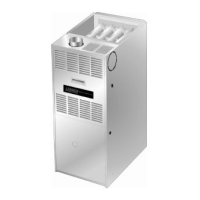Page 13
Use sheet metal shears to remove the cut out from the side
of the cabinet. Use the two provided sheet metal screws to
install the cut out on the top cap to cover the original flue
outlet opening. See figure 15.
The G40UH(X) series units are classified as fan−assisted
Category I furnaces when vertically vented according to
the latest edition of the National Fuel Gas Code (NFPA 54/
ANSI Z223.1) in the USA and the current CSA B149 Natu-
ral Gas and Propane Installation Codes in Canada. A fan−
assisted Category I furnace is an appliance equipped with
an integral mechanical means to either draw or force com-
bustion products through the combustion chamber and/or
heat exchanger.
NOTE − Use these instructions as a guide. They do not su-
persede local codes. This furnace must be vented accord-
ing to all local codes these installation instructions, and the
provided venting tables in these instructions
The venting tables in this manual were extracted from the
National Fuel Gas Code (NFPA 54 / ANSI Z223.1) and are
provided as a guide for proper vent installation. Proper ap-
plication, termination, construction and location of vents
must conform to local codes having jurisdiction. In the ab-
sence of local codes, the NFGC serves as the defining doc-
ument.
Refer to the tables and the venting information contained in
these instructions to properly size and install the venting
system.
IMPORTANT
Once the venting system is installed, attach the Dis-
connected Vent" warning sticker to a visible area of
the plenum near the vent pipe. The warning sticker
is provided in the bag assembly.
WARNING
Asphyxiation hazard. The exhaust vent for this fur-
nace must be securely connected to the furnace flue
transition at all times.
FLUE TRANSITION
COLLAR
VENT CONNECTION
VENT
PIPE
FURNACE
FIGURE 16
Use self−drilling sheet metal screws or a mechanical fas-
tener to firmly secure the vent pipe to the round collar of the
flue transition. If self−drilling screws are used to attach the
vent pipe, it is recommended that three be used. Drive one
self−drilling screw through the front and one through each
side of the vent pipe and collar. See figure 16.
Install the first vent connector elbow at a minimum of six
inches (152 mm) from the furnace vent outlet.
Venting Using a Masonry Chimney
The following additional requirements apply when a lined
masonry chimney is used to vent this furnace.
Masonry chimneys used to vent Category I central fur-
naces must be either tile-lined or lined with a listed metal
lining system or dedicated gas vent. Unlined masonry
chimneys are prohibited. See figures 17 and 18 for com-
mon venting.
A chimney with one or more sides exposed to the outside of
the structure is considered to be an exterior chimney.
An exterior masonry chimney that is not tile−lined must be
lined with B1 vent or a listed insulated flexible metal vent.
An exterior tile−lined chimney that is sealed and capped
may be lined with a listed uninsulated flexible metal vent.
If the existing chimney will not accommodate a listed metal
liner, either the chimney must be rebuilt to accommodate
one of these liners or an alternate approved venting meth-
od must be found.
Insulation for the flexible vent pipe must be an encapsu-
lated fiberglass sleeve recommended by the flexible vent
pipe manufacturer. See figure 17.
DO NOT insulate the space between the liner and the
chimney wall with puffed mica or any other loose gran-
ular insulating material
Common Venting Using Metal−Lined Masonry Chimney
4 in. (102 mm)
minimum
MIN. LENGTH −− AS
SHORT AS PRACTICAL
MAX. LENGTH
−− SEE NOTE 1
BELOW.
SEALED
PERMANENTLY
SEALED FIREPLACE
OPENING
EXTERIOR
CHIMNEY WITH
METAL
LINER
VENT CONNECTOR
SEE NOTE 2
NOTE 1 − Refer to the provided venting tables for installations in the USA
and the venting tables in CSA−B149 for installations Canada.
NOTE 2 − Either single-walled or double-walled vent connector may be
used. Refer to the capacity requirements shown in the provided venting
tables for installations in USA and the venting tables in current CSA−
B149 for installations in Canada.
OTHER
APPLIANCE
FURNACE
5 ft. (1.5 m)
minimum
FIGURE 17

